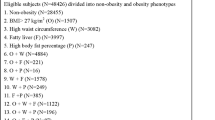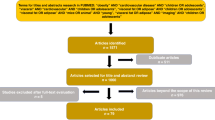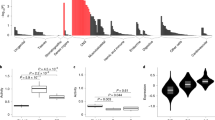Abstract
Objectives
Obesity is a risk factor for type 2 diabetes mellitus. Among obesity, visceral fat obesity, and ectopic fat obesity, it has been unclear which has the greatest effect on incident diabetes.
Methods
In this historical cohort study of 8430 men and 7034 women, we investigated the effect of obesity phenotypes on incident diabetes. Obesity, visceral fat obesity, and ectopic fat obesity were defined as body mass index ≥25 kg/m2, waist circumference ≥90 cm in men or ≥80 cm in women, and having fatty liver diagnosed by abdominal ultrasonography, respectively. We divided the participants into eight groups according to the presence or absence of the three obesity phenotypes.
Results
During the median 5.8 years follow-up for men and 5.1 years follow-up for women, 286 men and 87 women developed diabetes. Compared to the non-obese group, the hazard ratios (HRs) of incident diabetes in the only-obesity, only-visceral fat obesity, only-ectopic fat obesity groups, and with all-three types of obesity group were 1.85 (95%CI 1.06–3.26, p = 0.05) in men and 1.79 (0.24–13.21, p = 0.60) in women, 3.41 (2.51–4.64, p < 0.001) in men and 2.30 (0.87–6.05, p = 0.12) in women, 4.74 (1.91–11.70, p < 0.001) in men and 13.99 (7.23–27.09, p < 0.001) in women and 10.5 (8.02–13.8, p < 0.001) in men and 30.0 (18.0–50.0, p < 0.001) in women. Moreover, the risk of incident diabetes of the groups with ectopic fat obesity were almost higher than that of the four groups without ectopic fat obesity.
Conclusion
Ectopic fat obesity presented the greatest risk of incident type 2 diabetes.
This is a preview of subscription content, access via your institution
Access options
Subscribe to this journal
Receive 12 print issues and online access
$259.00 per year
only $21.58 per issue
Buy this article
- Purchase on Springer Link
- Instant access to full article PDF
Prices may be subject to local taxes which are calculated during checkout




Similar content being viewed by others
References
Japan Diabetes Clinical Data Management Study Group (JDDM) [Internet]. http://jddm.jp/data/index-2015.html Accessed 20 Aug 2017
NCD Risk Factor Collaboration (NCD-RisC. Worldwide trends in diabetes since 1980: a pooled analysis of 751 population-based studies with 4.4 million participants. Lancet. 2016;387:1513–30.
Fukuda T, Hamaguchi M, Kojima T, Hashimoto Y, Ohbora A, Kato T, et al. The impact of non-alcoholic fatty liver disease on incident type 2 diabetes mellitus in non-overweight individuals. Liver Int. 2016;36:275–83.
NCD Risk Factor Collaboration (NCD-RisC. Trends in adult body-mass index in 200 countries from 1975 to 2014: a pooled analysis of 1698 population-based measurement studies with 19·2 million participants. Lancet. 2016;387:1377–96.
World Health Organization. Obesity: preventing and managing the global epidemic. Report of a WHO Consultation (WHO Technical Report Series 894), 2000
Wajchenberg BL. Subcutaneous and visceral adipose tissue: their relation to the metabolic syndrome. Endocr Rev. 2000;21:697–738.
Shulman GI. Ectopic fat in insulin resistance, dyslipidemia, and cardiometabolic disease. N Engl J Med. 2014;371:1131–41.
Levelt E, Pavlides M, Banerjee R, Mahmod M, Kelly C, Sellwood J, et al. Ectopic and visceral fat deposition in lean and obese patients with type 2 diabetes. J Am Coll Cardiol. 2016;68:53–63.
Garrow JS, Webster J. Quetelet’s index (W/H2) as a measure of fatness. Int J Obes. 1985;9:147–53.
Janssen I, Heymsfield SB, Allison DB, Kotler DP, Ross R. Body mass index and waist circumference independently contribute to the prediction of nonabdominal, abdominal subcutaneous, and visceral fat. Am J Clin Nutr. 2002;75:683–8.
Fabbrini E, Magkos F, Mohammed BS, Pietka T, Abumrad NA, Patterson BW, et al. Intrahepatic fat, not visceral fat, is linked with metabolic complications of obesity. Proc Natl Acad Sci USA. 2009;106:15430–5.
Britton KA, Fox CS. Ectopic fat depots and cardiovascular disease. Circulation. 2011;124:837–41.
Byrne CD. Ectopic fat, insulin resistance and non-alcoholic fatty liver disease. Proc Nutr Soc. 2013;72:412–9.
Hamaguchi M, Kojima T, Takeda N, Nakagawa T, Taniguchi H, Fujii K, et al. The metabolic syndrome as a predictor of nonalcoholic fatty liver disease. Ann Intern Med. 2005;143:722–8.
Chitturi S, Farrell GC, Hashimoto E, Saibara T, Lau GK, Sollano JD. Asia-Pacific Working Party on NAFLD. Non-alcoholic fatty liver disease in the Asia-Pacific region: definitions and overview of proposed guidelines. J Gastroenterol Hepatol. 2007;22:778–87.
Expert committee on the diagnosis and classification of diabetes mellitus. Follow-up report on the diagnosis of diabetes mellitus. Clin Diabetes. 2004;22:71–79.
Hashimoto Y, Hamaguchi M, Kojima T, Ohshima Y, Ohbora A, Kato T, et al. Modest alcohol consumption reduces the incidence of fatty liver in men: a population-based large-scale cohort study. J Gastroenterol Hepatol. 2015;30:546–52.
Aaron DJ, Kriska AM, Dearwater SR, Cauley JA, Metz KF, LaPorte RE. Reproducibility and validity of an epidemiologic questionnaire to assess past year physical activity in adolescents. Am J Epidemiol. 1995;142:191–201.
Ryu S, Chang Y, Kim DI, Kim WS, Suh BS. gamma-Glutamyltransferase as a predictor of chronic kidney disease in nonhypertensive and nondiabetic Korean men. Clin Chem. 2007;53:71–77.
American Diabetes Association. Standards of medical care in diabetes--2011. Diabetes Care. 2011;34:S11–S61. Suppl 1
Hamaguchi M, Kojima T, Itoh Y, Harano Y, Fujii K, Nakajima T, et al. The severity of ultrasonographic findings in nonalcoholic fatty liver disease reflects the metabolic syndrome and visceral fat accumulation. Am J Gastroenterol Am J Gastroenterol. 2007;102:2708–15.
Ota T, Takamura T, Hirai N, Kobayashi K. Preobesity in World Health Organization classification involves the metabolic syndrome in Japanese. Diabetes Care. 2002;25:1252–3.
Japan Society for the Study of Obesity. Diagnostic criteria for obesity. J Jpn Soc Study Obes. 2011;17:1–78. (in Japanese)
Hashimoto Y, Hamaguchi M, Fukuda T, Obora A, Kojima T, Fukui M. Weight gain since age of 20 as risk of metabolic syndrome even in non-overweight individuals. Endocrine. 2017;58:253–61.
Hashimoto Y, Tanaka M, Okada H, Senmaru T, Hamaguchi M, Asano M, et al. Metabolically healthy obesity and risk of incident CKD. Clin J Am Soc Nephrol. 2015;10:578–83.
Misra A, Vikram NK, Gupta R, Pandey RM, Wasir JS, Gupta VP. Waist circumference cutoff points and action levels for Asian Indians for identification of abdominal obesity. Int J Obes. 2006;30:106–11.
Ministry of Health, Labour and Welfare. National Health and Nutrition Survey. 2016; p18. http://www.mhlw.go.jp/file/04-Houdouhappyou-10904750-Kenkoukyoku-Gantaisakukenkouzoushinka/kekkagaiyou_7.pdf. Accessed 1 Feb 2018
Knott C, Bell S, Britton A. Alcohol consumption and the risk of type 2 diabetes: a systematic review and dose-response meta-analysis of more than 1.9 million individuals from 38 observational studies. Diabetes Care. 2015;38:1804–12.
Umpierre D, Ribeiro PA, Kramer CK, Leitão CB, Zucatti AT, Azevedo MJ, et al. Physical activity advice only or structured exercise training and association with HbA1c levels in type 2 diabetes: a systematic review and meta-analysis. J Am Med Assoc. 2011;305:1790–9.
Mitsuhashi K, Hashimoto Y, Hamaguchi M, Obora A, Kojima T, Fukuda T, et al. Impact of fatty liver disease and metabolic syndrome on incident type 2 diabetes; a population based cohort study. Endocr J. 2017;64:1105–14.
Ballestri S, Zona S, Targher G, Romagnoli D, Baldelli E, Nascimbeni F, et al. Nonalcoholic fatty liver disease is associated with an almost twofold increased risk of incident type 2 diabetes and metabolic syndrome. Evidence from a systematic review and meta-analysis. J Gastroenterol Hepatol. 2016;31:936–44.
Feng RN, Zhao C, Wang C, Niu YC, Li K, Guo FC, et al. BMI is strongly associated with hypertension, and waist circumference is strongly associated with type 2 diabetes and dyslipidemia, in northern Chinese adults. J Epidemiol. 2012;22:317–23.
Mitsuhashi K, Hashimoto Y, Tanaka M, Toda H, Matsumoto S, Ushigome E, et al. Combined effect of body mass index and waist-height ratio on incident diabetes; a population based cohort study. J Clin Biochem Nutr. 2017;61:118–22.
Wander PL, Boyko EJ, Leonetti DL, McNeely MJ, Kahn SE, Fujimoto WY. Change in visceral adiposity independently predicts a greater risk of developing type 2 diabetes over 10 years in Japanese Americans. Diabetes Care. 2013;36:289–93.
Boyko EJ, Fujimoto WY, Leonetti DL, Newell-Morris L. Visceral adiposity and risk of type 2 diabetes: a prospective study among Japanese Americans. Diabetes Care. 2000;23:465–71.
Ludescher B, Rommel M, Willmer T, Fritsche A, Schick F, Machann J. Subcutaneous adipose tissue thickness in adults—correlation with BMI and recommendations for pen needle lengths for subcutaneous self-injection. Clin Endocrinol. 2011;75:786–90.
Milić S, Lulić D, Štimac D. Non-alcoholic fatty liver disease and obesity: biochemical, metabolic and clinical presentations. World J Gastroenterol. 2014;20:9330–7.
Yoshitaka H, Hamaguchi M, Kojima T, Fukuda T, Ohbora A, Fukui M. Nonoverweight nonalcoholic fatty liver disease and incident cardiovascular disease: a post hoc analysis of a cohort study. Medicine. 2017;96:e6712.
Hashimoto Y, Hamaguchi M, Fukuda T, Nakamura N, Ohbora A, Kojima T, et al. BMI history and risk of incident fatty liver: a population-based large-scale cohort study. Eur J Gastroenterol Hepatol. 2016;28:1188–93.
Matsuzaka T, Shimano H, Yahagi N, Kato T, Atsumi A, Yamamoto T, et al. Crucial role of a long-chain fatty acid elongase, Elovl6, in obesity-induced insulin resistance. Nat Med. 2007;13:1193–202.
Stefan N, Häring HU. The role of hepatokines in metabolism. Nat Rev Endocrinol. 2013;9:144–52.
Misu H, Takamura T, Takayama H, Hayashi H, Matsuzawa-Nagata N, Kurita S, et al. A liver-derived secretory protein, selenoprotein P, causes insulin resistance. Cell Metab. 2010;12:483–95.
Jung CH, Kim BY, Kim CH, Kang SK, Jung SH, Mok JO. Associations of serum fetuin-A levels with insulin resistance and vascular complications in patients with type 2 diabetes. Diabetes Vasc Dis Res. 2013;10:459–67.
Kim MK, Chun HJ, Park JH, Yeo DM, Baek KH, Song KH, et al. The association between ectopic fat in the pancreas and subclinical atherosclerosis in type 2 diabetes. Diabetes Res Clin Pract. 2014;106:590–6.
van der Zijl NJ, Goossens GH, Moors CC, van Raalte DH, Muskiet MH, Pouwels PJ, et al. Ectopic fat storage in the pancreas, liver, and abdominal fat depots: impact on β-cell function in individuals with impaired glucose metabolism. J Clin Endocrinol Metab. 2011;96:459–67.
Giannini C, Caprio S. Progression of β-cell dysfunction in obese youth. Curr Diab Rep. 2013;13:89–95.
Cuthbertson DJ, Bell JA, Ng SY, Kemp GJ, Kivimaki M, Hamer M. Dynapenic obesity and the risk of incident Type 2 diabetes: the English Longitudinal Study of Ageing. Diabet Med. 2016;33:1052–9.
Hashimoto Y, Osaka T, Fukuda T, Tanaka M, Yamazaki M, Fukui M. The relationship between hepatic steatosis and skeletal muscle mass index in men with type 2 diabetes. Endocr J. 2016;63:877–84.
Hernaez R, Lazo M, Bonekamp S, Kamel I, Brancati FL, Guallar E, et al. Diagnostic accuracy and reliability of ultrasonography for the detection of fatty liver: a meta-analysis. Hepatology. 2011;54:1082–90.
Fukuda T, Bouchi R, Takeuchi T, Nakano Y, Murakami M, Minami I et al. Ratio of visceral-to-subcutaneous fat area predicts cardiovascular events in patients with type 2 diabetes. J Diabetes Investig. 2017. https://doi.org/10.1111/jdi.12713.
Klein S. The case of visceral fat: argument for the defense. J Clin Invest. 2004;113:1530–2.
Byrne CD, Targher G. Ectopic fat, insulin resistance, and nonalcoholic fatty liver disease: implications for cardiovascular disease. Arterioscler Thromb Vasc Biol. 2014;34:1155–61.
Neville SE, Boye KS, Montgomery WS, Iwamoto K, Okamura M, Hayes RP. Diabetes in Japan: a review of disease burden and approaches to treatment. Diabetes Metab Res Rev. 2009;25:705–16.
Acknowledgements
We thank all of the staff members in the medical health checkup center at Murakami Memorial Hospital.
Author contributions
TO contributed to the data research and analyses and wrote the manuscript. YH originated and designed the study, analyzed the data and reviewed the manuscript for intellectual content. MH contributed to the manuscript organization and reviewed and edited the manuscript. AO and TK originated the study, analyzed the data and contributed to the discussion. MF analyzed the data and reviewed and edited the manuscript. HM is the guarantor of this work and, as such, had full access to all of the data in the study and takes responsibility for the integrity of the data and the accuracy of the data analysis. All authors were involved in the writing of the manuscript and approved the manuscript’s final version.
Author information
Authors and Affiliations
Corresponding author
Ethics declarations
Conflict of interest
YH received grants from the Fuji Foundation for Protein Research, outside the submitted work. MF reports grants from AstraZeneca plc, grants from Astellas Pharma Inc., grants from Nippon Boehringer Ingelheim Co., Ltd., grants from Daiichi Sankyo Co., Ltd., grants from Eli Lilly Japan K.K., grants from Kyowa Hakko Kirin Company Ltd., grants from Kissei Pharmaceutical Co., Ltd., grants from MSD K.K., grants from Mitsubishi Tanabe Pharma Corporation, grants from Novo Nordisk Pharma Ltd., grants from Sanwa Kagaku Kenkyusho Co., Ltd., grants from Sanofi K.K., grants from Ono Pharmaceutical Co., Ltd., and grants from Takeda Pharmaceutical Co., Ltd., outside the submitted work. The remaining authors have no conflict of interest.
Electronic supplementary material
Rights and permissions
About this article
Cite this article
Okamura, T., Hashimoto, Y., Hamaguchi, M. et al. Ectopic fat obesity presents the greatest risk for incident type 2 diabetes: a population-based longitudinal study. Int J Obes 43, 139–148 (2019). https://doi.org/10.1038/s41366-018-0076-3
Received:
Revised:
Accepted:
Published:
Issue Date:
DOI: https://doi.org/10.1038/s41366-018-0076-3
This article is cited by
-
Association between predicted fat mass, predicted lean mass, predicted percent fat and type 2 diabetes mellitus in Japanese adults: a retrospective study
BMC Endocrine Disorders (2024)
-
Predictive value of insulin resistance surrogates for the development of diabetes in individuals with baseline normoglycemia: findings from two independent cohort studies in China and Japan
Diabetology & Metabolic Syndrome (2024)
-
Severity of adipose tissue dysfunction is associated with progression of pre-diabetes to type 2 diabetes: the Tehran Lipid and Glucose Study
BMC Public Health (2024)
-
Association between weight-adjusted waist index and non-alcoholic fatty liver disease: a population-based study
BMC Endocrine Disorders (2024)
-
Correlation between the triglyceride-glucose index and arterial stiffness in Japanese individuals with normoglycaemia: a cross-sectional study
BMC Endocrine Disorders (2024)



